The AMD Radeon R9 380X Review, Feat. ASUS STRIX
by Ryan Smith on November 23, 2015 8:30 AM EST- Posted in
- GPUs
- AMD
- Radeon
- Asus
- Radeon 300
Meet the ASUS STRIX R9 380X OC
For the launch of the Radeon R9 380X AMD sampled us with ASUS’s STRIX R9 380X OC. Arguably the highest-end of the R9 380X launch cards, the STRIX R9 380X OC comes with a factory overclock tied for the largest of any R9 380X and a further optional overclock for $259.
| Radeon R9 380X Cards | ||||
| ASUS STRIX R9 380X OC | Reference R9 380X | |||
| Boost Clock | 1030MHz / 1050MHz (GPUTweak OC) |
970MHz | ||
| Memory Clock | 5.7Gbps GDDR5 | 5.7Gbps GDDR5 | ||
| VRAM | 4GB | 4GB | ||
| Length | 10.75" | N/A | ||
| Width | Double Slot | N/A | ||
| Cooler Type | Open Air | N/A | ||
| Price | $259 | $229 | ||
The STRIX R9 380X is the latest entry in ASUS’s popular STRIX family of cards. At one point STRIX was ASUS’s brand for upscale video cards, occupying a slot between their standard cards and their high-end Republic of Gamers cards, but at this point with the majority of ASUS’s cards falling under the STRIX branding, it arguably has transformed into what is their de facto mainstream lineup of video cards.
The STRIX R9 380X OC ships at 1030MHz for the core clock, a 60MHz (6%) boost over the reference R9 380X. On top of that ASUS offers a pre-programmed 1050MHz mode via their GPU Tweak software, though a further 20MHz overclock is going to be pretty small in the long-run. Otherwise ASUS only touches the GPU clockspeed, leaving the memory clock at AMD’s default of 5.7Gbps. Out of the box, the STRIX R9 380X OC is going to be around 4% faster than a reference R9 380X card.
Like the other STRIX cards we’ve looked at this year, ASUS has been focusing on workmanship and a common visual theme for these cards. The STRIX R9 380X OC features a version of one of ASUS’s DirectCU II coolers, combining an oversized fan assembly with a 3 heatpipe heatsink assembly. The fan assembly in turn uses a pair of the company’s “wing-blade” fans, each measuring 94mm in diameter and giving the fan assembly its overall large size.
As is usually the case on ASUS cards, the STRIX R9 380X OC implements ASUS’s variation of zero fan speed idle technology, which the company calls 0dB Fan technology. While ASUS is no longer the only partner shipping zero fan speed idle cards, they are still one of the most consistent users of the technology, and surprisingly we still don’t see this in every open air card released on the market.
Sitting below the fan assembly, the DirectCU heatsink being used in ASUS’s 380X card is a typical tri-pipe configuration. The aluminum heatsink runs virtually the entire length of the card – and past the PCB – with a pair of 8mm heatpipes and a 10mm heatpipe providing additional heat transfer between the Tonga GPU and the rest of the heatsink. ASUS’s design doesn’t make contact with anything other than the GPU – so the GDDR5 RAM chips sit uncovered – with the airflow coming through the heatsink being sufficient to cool those chips.
Moving on to the PCB, ASUS has implemented their standard Super Alloy family of MOSFETs, capacitors, and chokes. ASUS uses an 8 phase VRM system here, taking advantage of the already oversized fan assembly to allow them to use a slightly taller than normal PCB to fit all of the power phases.
Flipping over to the back side of the card, we find a full-size backplate running the length of the card. There are no critical components on the back of the card, so while the backplate doesn’t provide any cooling it does serve to protect the card and reinforce it against bending. To that end a small lip extends past the backplate and meets up with the heatsink, preventing the heatsink from flexing towards the board. Small details such as these are why the STRIX cards have consistently been the most solid of the custom cards to make it through our hands this year, as the card is well-supported and isn't free to warp or bend.
Looking at the back we can also see the two 6-pin power connectors used to supply additional power to the card, along with the red and white power LEDs for each connector. Like some of their other cards, ASUS has flipped the PCIe power connectors so that the clip is on the back side of the card, keeping the clip clear of the heatsink and making it easier to plug and unplug the card. On a side note, I suspect this will be one of the last cards we review with two 6-pin connectors rather than a single 8-pin connector. Though electrically equivalent (150W), we’re already seeing cards like the R9 Nano shipping with the single 8-pin connector, and dual 6-pin connector cards will become increasingly rare.
As for Display I/O, ASUS is using a rather typical 1x DL-DVI-I, 1x DL-DVI-D, 1x DisplayPort, 1x HDMI port configuration. Multiple DVI ports, though not in any way petite, have been a common fixture on sub-$250 cards this generation and will likely remain that way for some time to come due to slower adoption of newer display I/O standards in the APAC market, which only recently has finally seen analog VGA phased out.
Finally, on the software front, the STRIX R9 380X OC includes ASUS’s GPU Tweak II software. The software hasn’t significantly changed since we last looked at it in July, offering the basic overclocking and monitoring functions one would expect from a good overclocking software package. GPU Tweak II allows control over clockspeeds, fan speeds, and power targets, while also monitoring all of these features and more.
Wrapping things up, as briefly mentioned earlier the STRIX R9 380X OC is the most expensive of the R9 380X launch cards. ASUS is charging a $30 premium for the card over AMD’s reference MSRP, putting the price at $259. Premium, factory overclocked cards aren’t anything new, but it does mean ASUS is in a bit of a precarious spot since the much more powerful Radeon R9 390 cards start at $289, meaning the premium price further amplifies the spoiler effect of the R9 390.


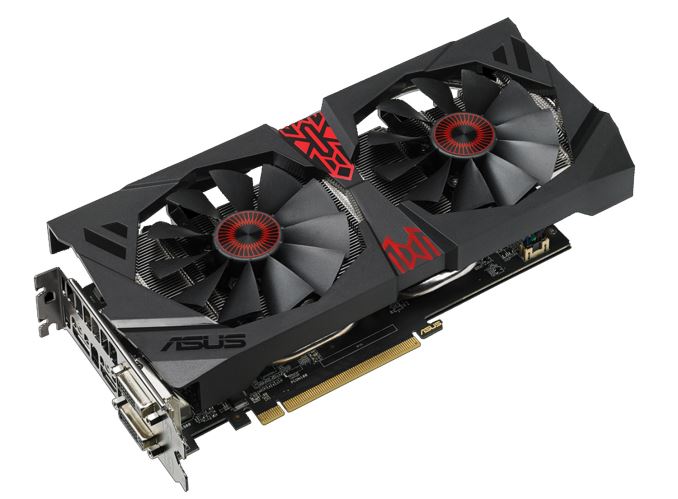
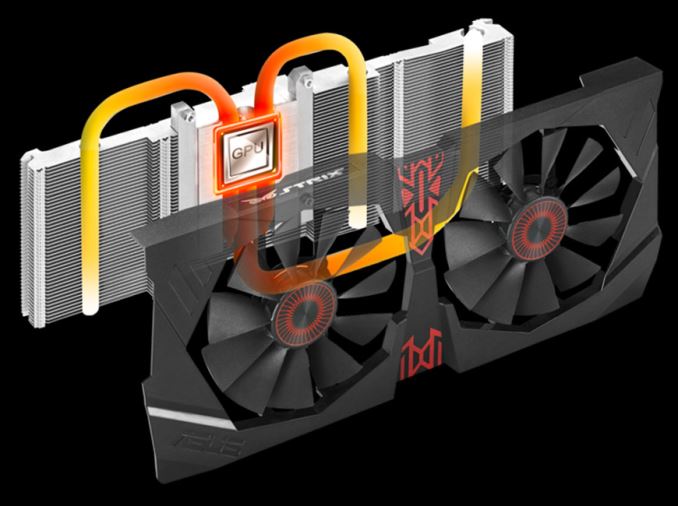
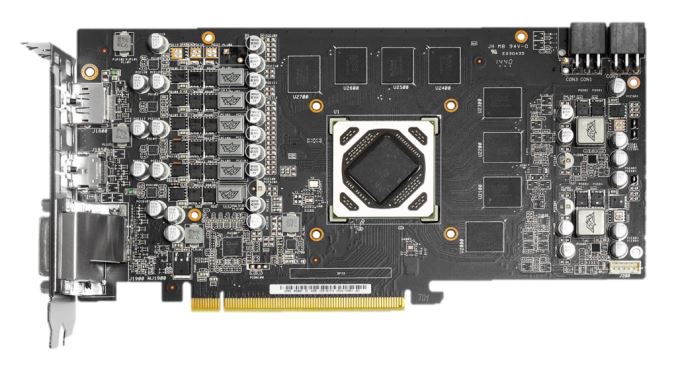
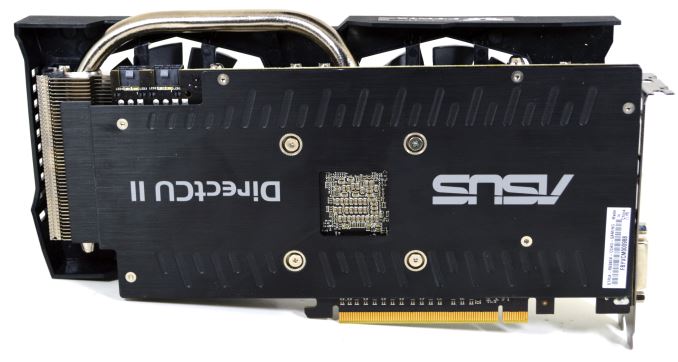

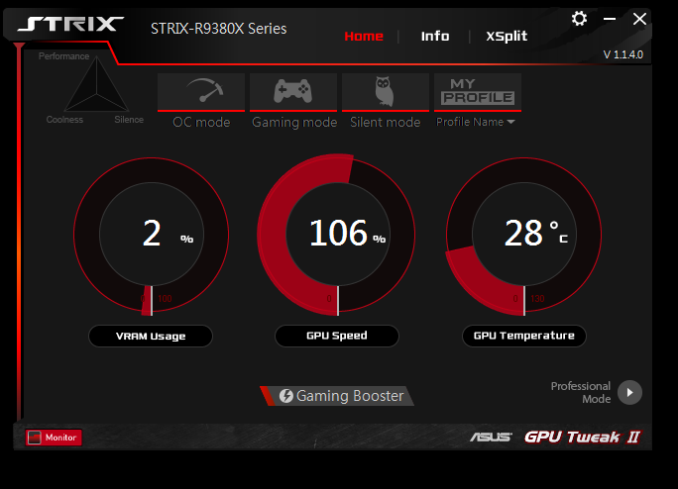








101 Comments
View All Comments
Asomething - Tuesday, November 24, 2015 - link
The HSA foundation is partially founded by ARM which means they are already working on it (but as you said there isnt much motivation to make HSA enabled apps). AMD is the only high profile and headline grabbing member of it so they tend to get the most press because of clickbait articles. And a lot (if not all) of nvidia's efficiency improvements do come from the lower transistor density (also the main reason they can say their TDP is so low since the chip has a larger surface area with which to dissipate the same amount of heat as the same chip made using AMD's high density libraries would have), improvements to the memory and reductions in DP capabilities.tamalero - Tuesday, November 24, 2015 - link
anyone can explain me why everyone says the new gpus are overpriced?their pricepoints seems to be similar to the performance of the nvidia cards.
the table on the first page shows clearly.
Even the review shows the 970 and the AMD 390 trading blows and have the same price point.
so, what did I miss? why suddenly fanboys demand even 15% reduction to "become competitive" ?
FriendlyUser - Tuesday, November 24, 2015 - link
As everyone has noted, the cards are uncomfortably close to the higher tier (390 and 970). So, the 380X is not overpriced with respect to the competition from nvidia, but with respect to the 390. The jump in performance is so great, that we should either hope the 390 goes at $300 (practically eliminating the 380X) or the 380X completely dominates the sub-200 territory.Anyway, overall it's a very good product.
just4U - Friday, November 27, 2015 - link
Well.. here in Canada that's not quite the case. A 380/960 /w 4G mem sells for 300ish.. the 380X $330.A 970 runs you $450-500 and a 390 $430+ No way their priced similar to the 970/390.
BurntMyBacon - Tuesday, November 24, 2015 - link
@Samus: "They need to drop the prices across the entire line about 15% just to become competitive."That wouldn't fix the biggest pricing problem shown in this review. The 380X is priced too closely to the 390 given the performance difference. Drop them both by 15% and the 380X is still priced too closely to the 390. I'll leave the rest of you to argue performance vs premium cooler value on the high end and 390/390X vs GTX970/GTX980 performance per dollar, but I submit that a flat 15% drop is too simple an answer to the problem due to competition within their own lineup.
Azix - Wednesday, January 13, 2016 - link
but people were fine with the 960 at the same price...zeeBomb - Monday, November 23, 2015 - link
Ryan smith blessed us with a great graphics card review.maecenas - Monday, November 23, 2015 - link
At this point, NVIDIA or AMD, I'm not sure I would get anything other than an ASUS cooling system. I have the STRIX version of the GTX 970 and it really is fantastic.jasonelmore - Monday, November 23, 2015 - link
It Depends on what you need. The Stock Blower Coolers keep hot air out of the case, so for Small Form Factor Builds, your not going to want Asus's coolers since they dump the hot air back into the case.theduckofdeath - Tuesday, December 1, 2015 - link
I have a mATX case with water cooling and internal padding all around to keep the noise down, and my ASUS Strix GTX 960 is not making a sound and the temp in the case does not go above 50-52 degrees celsius even after hours of playing. The problem with GPUs sucking air out from the rear and blowing the same air out is, they have to generate all of the airflow themselves, which always gets really noisy compared to using the air passing through a case.